There is still much to process from the Bodies Politic Symposium. As soon as the Owen Boss, Emma O’Kane and Karen Till made the first presentation about These Rooms (a collaboration between Anu and CoisCeim Dance Theatre based on the testimony of female witnesses to the little known and unusually cruel execution of 15 innocent civilians during the Easter Rising), I knew that it was going to be a rich, stimulating day.
What was fascinating, as the day progressed, was to see a common energy and sense of shared cause in what might have been disorientatingly diverse material. By the end of the day, we could sense the potential of what Jesse Jones called, a radical solidarity between queers, feminists, people with disabilities, travellers, and other bodies long marginalised for their deviance (this true even of that ‘deviant’ majority – women – whose embodiment has long been stigmatised and consequently policed and disciplined.)
Rosaleen McDonagh, in conversation with Lian Bell, spoke of a similar alliance, since Stonewall, between the queer and the disabled. However, she cautioned against complacency in the wake of the Marriage Equality Referendum that made people feel that Ireland had declared its progressive potential (and capital has been quick to trumpet Ireland as a destination for gay weddings, making sure that there’s money to be made from this progress). The deaths of Travellers in the Carrickmines fires and subsequent threat of mass evictions of Traveller families as a result of fire safety audits on halting sites in the wake of the tragedy, illustrates to her the racism and discrimination that still exists in Ireland, a racism she experienced as a child when a yellow line divided the playground between where the traveller and the settled kids could play. Her conversation with Lian, despite this topic, was joyful and mischievously humorous, as these photos suggest.
When I think of that apartheid dividing line, I’m aware of the power that can institute such a line. It’s a power that discriminates against traveller bodies, assigning them a particular place (travellers being a disturbingly mobile population for a settled authority), it is a power that also limits the settled children, who are corralled, albeit with significantly more privileges on their side of the line.
This thought struck me as we celebrated the energy of radical solidarity that seemed to be generated by the symposium’s participants. I wondered if our solidarity could be inclusive. Patriarchy has traditionally disembodied the standard male. His is a body that doesn’t need to account for itself. It is neutral and part of its power over non-standard bodies is that his is invisible, not available to scrutiny. The result has been huge privilege and inequity, but it comes at a cost for actual men, who ignore their own embodiment and find it difficult to communicate about it, particularly its vulnerability. As Caitlin Moran explains to men in recent article in Esquire, ’12 Things About Being A Woman That Women Won’t Tell You’:
Because remember that patriarchy’s bumming you as hard as it’s bumming us. We’re bulimic, objectified and under-promoted. You, meanwhile, are unable to talk about your feelings lest you get punched in the nuts by “a lad” telling you not to be “a bender”. You are unlikely to get custody of your kids, and are three times more likely to commit suicide. Feminism’s about sorting all this stuff out. Because it’s about equality. Not burning the penises. I can’t emphasise enough how much it’s not about burning penises. No burnt penises here.
The queer, the disabled, women are acutely aware of their corporeal vulnerability, but that vulnerability, that susceptibility to injury and mortality, is also what opens us up to our connections to others and to their ethical claim on us (Judith Butler and Paul Harrison among others helps me formulate this thinking, in case you’re interested).
Some of the things that I’m particularly pleased about is that we could have the conference in Maynooth, particularly in the South Campus and in the corridors of the old seminary under the exclusively male gaze of the imposing clerical portraits on the walls. This is an environment where a wooden screen separates seminarians from other students in the refectory. I detected a glee in some of the speakers at realising how speaking about their work, their rights, their bodies was particularly radical act in this context.
Seeing photos of Liv dancing the small piece of movement we prepared from The Casement Project, I realise just how prominent the crucifix and religious photos were in that room.
I’m pleased that there was dancing in the symposium.
Not just Jesse’s calmly powerful material, not just the short solo that Liv danced in the middle of the room, whipping up an energy and power that embodied much of what other speakers had alluded to, but also the whole audience in movement: not wanting to go over too much of The Casement Project‘s promotional blurb in my presentation of it (there are many other situations when I have to make sure I’m communicating the aspirations and the components of the project), I spoke about the motif of the interlinked arms in the work.
I showed the poster image, the images from Choreodrome when I first introduced interlinking to the dancers, Casement’s photo of the three men dancing in Puatamayo that prompted the interlinking and some footage of Aoife and me working through that image. More importantly I asked people to try out the interlinking with each other, creating simple connections and bodily contact, a collective body made from the impulses of its constituent individual bodies.
I’d like to think that these small moments of focusing on the physical, as we did also with a body-scanning and body-centring activity at the beginning and end of the day, helped participants to tune in to themselves and others in a way that isn’t typical of the usual, cerebrally-focused symposium. A whoosh of Mexican wave helped too.
One final thing that pleased me was the transformation of the straight lines of chairs which we’d set up in the hall at the beginning of the day, into circles and other groupings by the end. That’s important to me because I’d like all structures to be flexible and adaptive to the necessities of the moment. I was happy to start the day in traditional theatre/lecture layout, since that format works for the kind of communication we needed at that point. But when we needed to see Liv more clearly, or create more opportunities for participants to talk to each other, it was important that people could alter the arrangement to facilitate those needs.
The structures can change. The choreography can be different, but we need to be aware of how it’s working now and what tools we have to alter it.

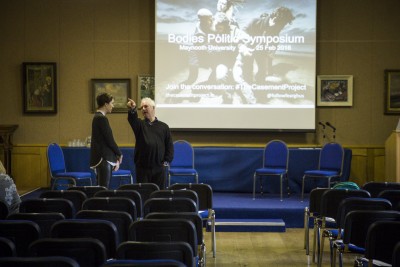
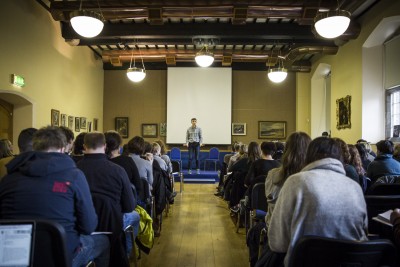
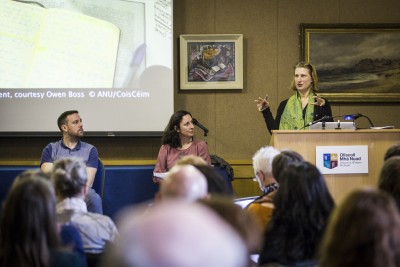
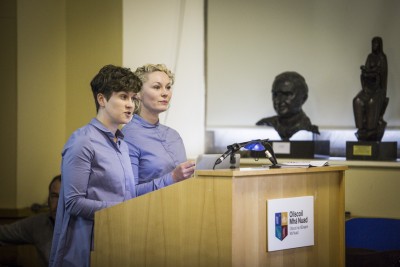
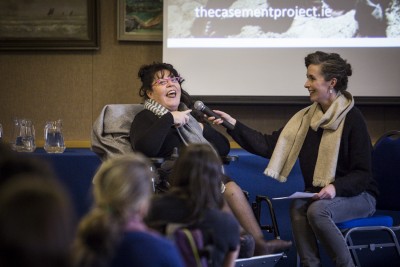
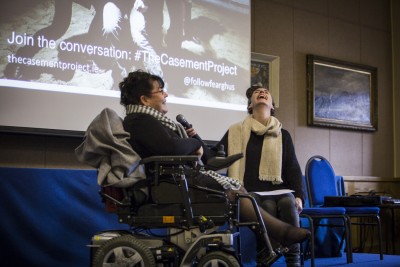
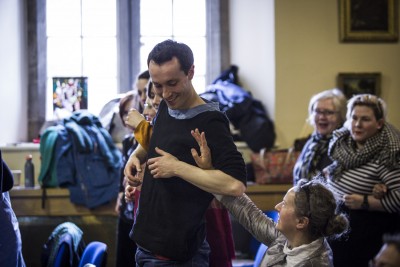
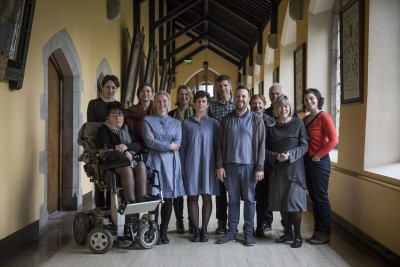
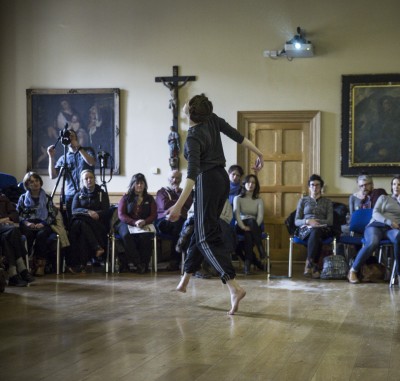
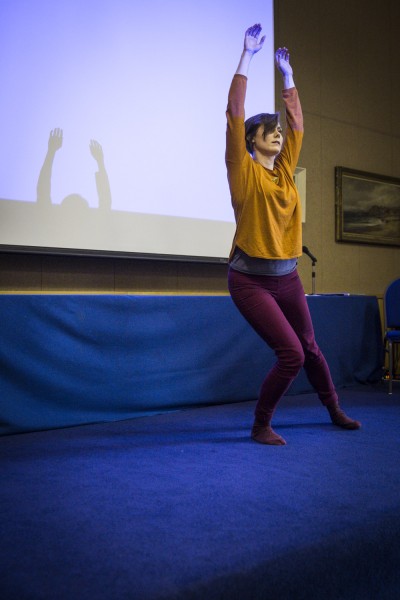
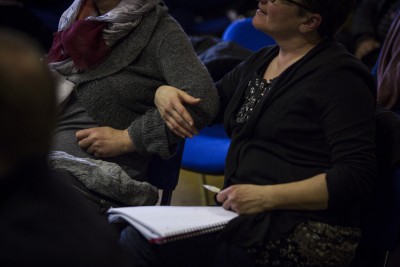
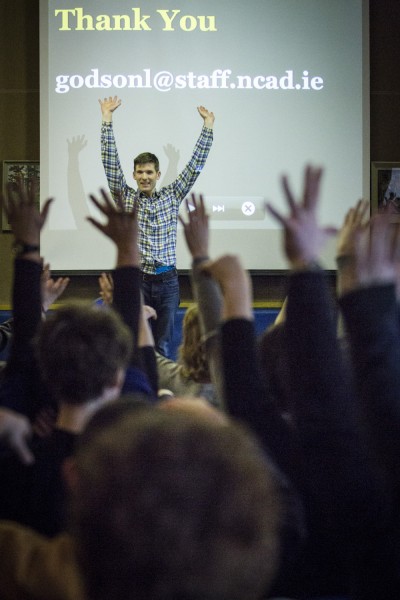
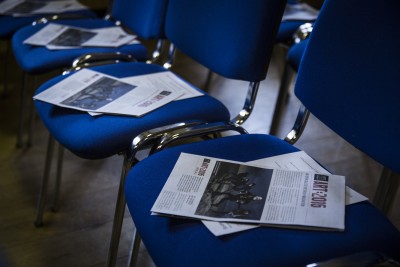
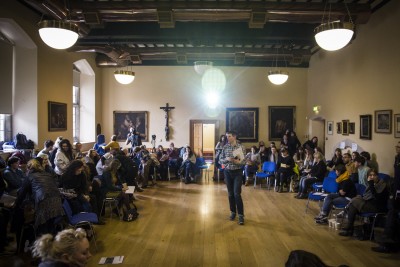
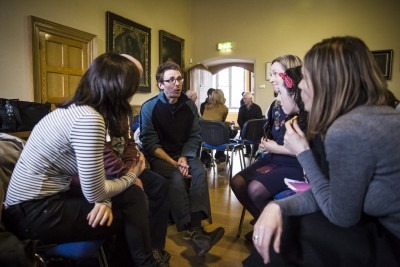
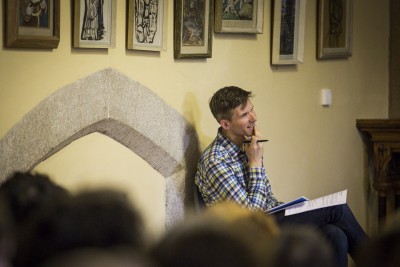

Pingback: Bodies Politic Symposium, 25 February 2016 – The Geographical Turn
Pingback: Report by Professor Gerry Kearns, Geography Department, Maynooth University – Maynooth University Decade of Commemorations